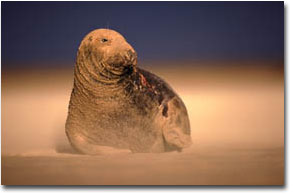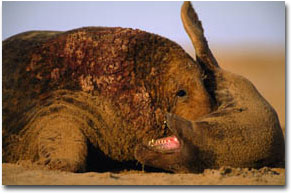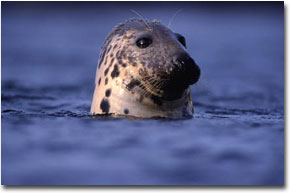|
|
 Grey Seals
Text and photography Copyright Niall Benvie
I’m not a great fan of wildlife circuses and the locations and individual animals I enjoy working most are the ones that receive the least attention from other photographers. Nevertheless, the prospect of some good grey seal photography that didn't involve a boat trip or five mile trek to some remote beach proved too much of a lure last December and I headed to the east coast of England, along with everyone else. These English rookeries differ from those in Scotland and Wales insofar as they occur on sandbanks and beaches; in the north and west, the species favours rocky shores, preferably on uninhabited islands, and sea caves. Unlike its smaller relative, the common or harbour seal, the grey seal normally stays well clear of people. Grey seal pups spend at least the first three weeks of their lives on-shore, before their mothers leave them to fend for themselves. Seal’s milk, with its 55% fat content, ensures rapid growth. This period ashore, as well as their conspicuous white coat, makes them more vulnerable to predation than common seal pups which can take to the water within a few hours of birth and accounts for their shyness. Around half the world population of grey seals lives around British shores, and ninety percent of those are in Scottish waters. Legal protection (and on some islands, such as the Monachs, the end of permanent human settlement) have allowed the population to rise from a low-point earlier this century of about 500 animals to more than 100,000 today. Their tolerance of people on the beaches of eastern England can be seen as a response to a lack of living space as overspill occurs from population centres.
From a photographic point of view, an open sandy beach has a lot of advantages. For one thing, it is exposed to the full-bodied light of dawn and dusk; my best Scottish site is entirely in the shade by the time the pupping season comes round in mid-October. The sand itself is reflective, introducing warm hues and improving light levels. The animals, even white-coated pups, stand out well against sand which is not always the case when they are lying on seaweed covered rocks. The day we arrived at the site, a storm was raging across the water in Denmark which felled more than 70% of that country’s forest cover. The tail end of the storm created challenging working conditions for us as sand filled the air, threatening to penetrate every corner of camera and lens. After twenty minutes, my 500mm was crunching on sand if I focused manually. Anticipating that blowing sand might be a problem, I had brought with me a bivvy bag in which I intended to change films but the fierce gusts made it impossible to set up and instead, I sought shelter in a small lean-to on the beach. Fortunately, none of the 30 rolls of film I exposed over the next two days suffered scratching.
Looking beyond the dozens of animals nearby, my attention was caught by a bull a little further out on the beach who was completely caked and making sure that he kept his head above the worst of the blowing sand. The brooding sky above was just the right complement to his heroic pose. In the violent wind, I abandoned the tripod in favour of a beanbag resting it on a beer crate I had borrowed from the place we were staying. With the huge lens hood removed too, I was assured sharp exposures. There was a big range in contrast between the dark sky and the pale, sunlit sand, so I based my exposure on a spot reading taken from the animal’s chest, just where the pale merges into the dark. A quick check of the exposure for the paler head, my most important highlight, showed that it still fell within the two-stop-brighter-than-mid-tone range, meaning that highlight detail would be complete. I had time to make only four exposures before the animal decided that he’d had enough and he turned and shuddered towards the other seals in search of shelter. There is perhaps something incongruous about a seal in a “desert storm” - we naturally associate them with the sea. But this is what I witnessed and for me, a view which challenges the received wisdom about seals is enough justification to join the circus.
Planning
Watch out for sunset beach shots with seals as an element in the composition and traces of the seals in wet sand. Much of the sparring between males takes place at the edge of the sea - which is a bit more interesting than on the beach. Niall Benvie - NPN 018 Comments on this article? Send them to the editor. |
|
|
 Great conditions for photography, less so for the seal and camera. These open eastern beaches get the full benefit of weather conditions on nearby continental Europe.
Great conditions for photography, less so for the seal and camera. These open eastern beaches get the full benefit of weather conditions on nearby continental Europe.
 Of the few large mammals we have in the UK, grey seals are one of the most conspicuous. Rarely, however, do they permit such an open approach, allowing us the opportunity of getting a whole range of behavioural pictures.
Of the few large mammals we have in the UK, grey seals are one of the most conspicuous. Rarely, however, do they permit such an open approach, allowing us the opportunity of getting a whole range of behavioural pictures.
 This one was fun to take; not only was my F5's auto focus on the blink, but the rapidly advancing tide made me wonder about the wisdom of the water-level perspective.
This one was fun to take; not only was my F5's auto focus on the blink, but the rapidly advancing tide made me wonder about the wisdom of the water-level perspective.